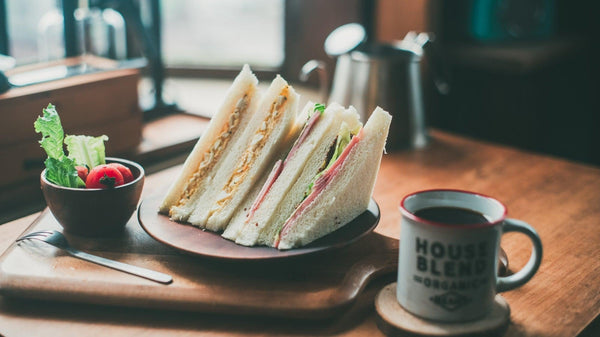
Jump to:
If you’re planning a trip to Japan or thinking about enjoying a Japanese meal, you’ve probably already got some ideas of what typical Japanese cuisine consists of. Sushi, tempura, or ramen may come to mind – or perhaps tonkatsu, wagyu, grilled fish or gyoza.
But what about sandwiches?
Wait, you say, sandwiches??
Yes! Japanese sandwiches are a food staple in this island nation, whose culture has been known to take an import, adapt it for local use, and then expand or evolve it into an art.
The “sando” or sandwich is a prime example of this phenomenon, so much so that many non-Japanese are surprised and highly impressed when eating a sandwich in Japan for the first time.
From savory delights like the katsu sando to the delightfully infused fruit sandwiches (yes, that is a thing!), these hand-held creations are more than just food; they're a portal into modern Japan’s culinary tapestry that blends east with west.
History Of Sandwiches In Japan
The history of Japanese sandwiches can be traced back to the 16th century when Portuguese and Dutch traders introduced bread to Japan.
During the Edo period (1603-1868), a time of isolation from the rest of the world, bread was seen as a foreign and exotic food. Then in the early 19th century, Japan began to open up to the outside world in what’s known as the Meiji Restoration. This led to a growing interest in Western food, including sandwiches.
In the 1850s, Western-style restaurants began to appear in major Japanese cities, and they offered sandwiches on their menus. The first Japanese-style sandwiches began to appear in the late 19th century. These sandwiches incorporated Japanese ingredients and flavors, such as mayonnaise, pickled ginger, and umeboshi plums.
Why Japanese Sandwiches Are Popular Today

Sandwiches are popular in today's Japanese society for a number of reasons. They are convenient and portable, versatile, affordable, and seen as healthy. They are also associated with Western culture, which has always had a certain appeal in Japan.
Always known as a rice country, Japan has also become a bread culture – you can read more about this in our article on sweet and savory Japanese bread.
Japanese sandwiches are convenient because they can be readily made at home or bought from a store with good, consistent quality. They can also be eaten on the go, making them a popular choice for busy people.
The sando is also versatile because it can be made with a variety of fillings, both savory and sweet – and can be enjoyed by people of all dietary restrictions and preferences.
The Art Of Japanese Sandwiches: How “Sando” Is Different From Its Western Counterparts
Japan is known across the world for its culinary craftsmanship.
The same level of meticulous attention to detail that defines intricate sushi and delicate wagashi sweets extends to the realm of sandwiches, affectionately referred to as "sando" in Japan. These are not just sandwiches; they're edible art – a symphony of textures, flavors, and colors that come together to create a multisensory experience.
From selecting quality ingredients to arranging them with precision and care, the Japanese sandwich is a reflection of its cultural tradition of balance and harmony.
A good katsu sando (cutlet sandwich), for instance, embodies the perfect equilibrium between crispy (pork or chicken) cutlet, velvety bread, and savory tonkatsu sauce. This uniquely Japanese sandwich creation transcends the sum of its parts to become an unforgettable delight.
Bread As A Base: Why Shokupan Makes The Japanese Sandwich Superior

At first glance, a Japanese sandwich might look like two ordinary slices of “Wonder” bread with a featured array in the middle.
But make no mistake, that’s no ordinary sliced bread – though we’ll dare say that it’s the best thing since!
The fundamental element of any sando is shokupan, aka Japanese milk bread. This Japanese version of sandwich bread is known for its delicate feel and slightly sweet flavor. Telltale signs of shokupan (versus other kinds of sandwich bread) include:
- Soft fluffiness
- Light springiness
- Milky creaminess
- Rectangular block shape
- Subtle, balanced sweetness
Shokupan is sold in bakeries, supermarkets, konbini (convenience stores), and other retail outlets in Japan – in thickness that ranges from 4 to 10 slices per (equally sized) package of bread. The thick-cut (4-slice, like Texas Toast) shokupan is Instagrammable and goes great for katsu sando and the like, while thinner slices work well for the ubiquitous tamago sando (Japanese egg sandwich) and others.
Its crust is often removed to make the Japanese sando, as that gives the most visual appeal. If you’re thinking “but that’s wasteful,” fear not, in this culture waste is not tolerated – the crust can be used for bread crumbs (panko) or croutons.
If you’re endeavoring to make a Japanese sando and don’t have shokupan, why not make it? We wrote an article all about how to bake shokupan, in fact, and you can get some of the tools right here on Japanese Taste.
With the bread down, let’s delve into the types of Japanese sandwiches that have become mainstays.
Katsu Sando: A Crispy Overture Of Flavors

At the center of Japan's sandwich board is the iconic katsu sando, which brings together the crunchy allure of a breaded, fried cutlet with the pillowy embrace of shokupan.
The crispy exterior of the katsu – be it pork, chicken, or even seafood – balances the softness of the bread to create a delightful sensory juxtaposition. Add to this the umami-rich tonkatsu sauce and the earthy freshness of shredded cabbage, and you have a masterpiece that captures the essence of Japanese culinary craftsmanship.
While pork is the traditional protein of the katsu sando, it’s common to see chicken katsu sando in Japan nowadays, with shrimp or fish cutlets gaining popularity in the katsu sando game.
Katsu sando are sold and served nearly everywhere in Japan, from simple forms at the konbini (convenience store) to elevated katsu sando at underground food halls in department stores. Whether you want a sandwich for lunch at work or are planning to serve an array of finger foods at a party or event, you can’t go wrong with a katsu sando.
Want to make a katsu sando at home? We’ve got you covered with this article that tells you how.
Tamago Sando: The Egg (Sandwich) That Definitely Comes First

The Japanese culinary ethos revolves around the appreciation of the ordinary, elevating it to the extraordinary through precision and care.
The tamago sando exemplifies this philosophy: a humble egg sandwich that transcends its components to become a staple of Japanese sandwichery, a much-appreciated sandwich art form that belies its simplicity with heavenly flavor and texture.
Encapsulating simplicity in every sense, a delicately whipped egg salad – slightly sweet and incredibly tender – finds its home between slices of shokupan. And of course, it’s no ordinary mayonnaise that goes into the tamago sando – it’s the umami-packed Kewpie mayonnaise that brings a depth of flavor and mouthfeel like no other.
The Japanese egg sandwich tells a story of comfort and familiarity, with simple ingredients transformed into a culinary treasure through meticulous craftsmanship. It's a gentle reminder that true artistry lies in embracing the essence of each element to create a harmonious whole.
The Japanese Fruit Sandwich: A Symphony Of Colors And Flavors

While savory sando dominates the Japanese sandwich scene, this culture’s culinary imagination doesn't stop at the boundaries of salt and umami.
While admittedly having been known to leave some non-Japanese taken aback at the combination, be assured that this breed of Japanese sandwich is not to be overlooked.
Enter the enchanting world of Japanese fruit sandwiches.
This exquisite interplay of flavors and aesthetics celebrates the natural sweetness of fruits within the sweet-and-savory embrace of shokupan.
Imagine sinking your teeth into a textural medley of fluffy bread, silky cream, and vibrant fruits such as strawberries, kiwi, or mangoes. The fruit sandwich is a canvas of colors, a palette (for the palate) of tastes that transforms every bite into a burst of summer on the tongue.
“Fruits sando” (as they are lovingly called in Japanese) are a delectable and refreshing summer treat – but they make an excellent meal addition any time of the year, whether you’re serving up fare for guests or want to give those sweet-toothed kids something new and bold to experience.
Onigirazu: When Tradition Meets Contemporary Convenience

So far we’ve talked about how the Japanese have imported, adapted, and embraced a heretofore thought of as a western concept, the sandwich. But the evolution doesn’t stop at that.
The onigirazu — a fusion of onigiri rice balls and sandwiches — is an example of how food has evolved within Japan. A staple of Japanese food going back literally two millennia, the onigiri or rice ball started with sustenance in mind – but has evolved over time to an elevated form. Onigiri are constantly on the konbini shelves and in the display counters – and seemingly every Japanese person will happily tell you how they grew up on homemade onigiri.
But on its own, onigiri isn’t exactly a sandwich, as the middle is not at all exposed but rather ensconced in rice. The onigirazu, however, offers a twist of Japanese sandwichery on the beloved onigiri. Onigirazu are sliced and displayed open-faced, and to many people (Japanese and non-Japanese alike) resemble a sandwich in this form.
Layers of rice, fillings, and nori seaweed create a portable delight with visual appeal. From teriyaki chicken to seafood and veggies, the possibilities are as diverse as they are delicious. The onigirazu showcases Japan's ability to take something that’s largely been taken for granted and transform it into a new and exciting form.
What a testament to culinary evolution that respects its roots but dares to push ahead!
Crafting Your Japanese Sandwich Adventure At Home

Bringing the art of Japanese sandwiches into your kitchen is an enriching endeavor that lets you experience the craft firsthand. The joy of creating these culinary delights lies not only in the final product but also in the process — a process that allows you to infuse each step with your own creativity and passion. To embark on this flavorful journey, consider the following steps and ingredients/tools that are readily available on our website.
1. Japanese Milk Bread (Shokupan): The Heart of Every Sando
Japanese milk bread, known as shokupan, serves as the canvas upon which your culinary artistry unfolds. Its cloud-like softness and subtly sweet flavor provide the perfect foundation for your sandwiches. You can find tools to make authentic shokupan on our website, ensuring that your homemade Japanese sandwiches are as close to the originals as possible.
2. Quality Fillings: Elevating Your Sandwiches
While bread is the heart, the soul of the Japanese sandwich lies in its fillings. Opt for the best ingredients to create sandwiches that truly tantalize your taste buds. Here are a few suggestions:
- Katsu Sando: Tender and crispy katsu elevates your sandwiches to a new level. Choose from pork, chicken, or even seafood katsu, and let its deliciousness shine.
- Tamago Sando / Japanese Egg Sandwich: The delicate sweetness of Japanese egg sandwich or tamago sando brings a comforting touch to your sandwich roster.
- Fruit Sando / Japanese Fruit Sandwich: For a refreshing twist, embrace the beauty of a fruit sandwich. Choose from an assortment of fresh fruits like strawberries, kiwi, and mangoes to add a burst of natural sweetness.
3. Condiments and Sauces: Flavorful Enhancements
Elevate your sandwiches with a range of condiments and sauces that bring depth and complexity to your creations:
Tonkatsu Sauce

This rich, tangy, and slightly sweet sauce is a staple in Japanese cuisine. Tonkatsu sauce is the perfect companion for katsu fillings, adding a burst of umami.
Japanese Mayonnaise

Japanese mayonnaise is renowned for its creamy texture and distinct flavor. Kewpie Mayo is a versatile condiment that can be used in various sandwiches, from katsu to fruit sando.
4. Fresh Produce: Adding Texture and Freshness
Crisp lettuce, juicy tomatoes, and other fresh vegetables provide layers of texture and freshness to your sandwiches. Quality produce not only enhances the flavor profile but also contributes to the visual appeal of your creations.
5. Kitchen Tools: Elevating Presentation with Japanese Sandwich Makers
Presentation is an integral part of Japanese culinary culture, and the same applies to sandwiches. Consider investing in one or more of the following Japanese sandwich maker tools to ensure that your Japanese sandwiches are as visually appealing as they are delicious.
Japanese sandwich makers or molds can help you achieve the perfect shape and presentation for your homemade sando.
6. Onigirazu: A Fusion of Tradition and Innovation
If you're looking for a unique twist, delve into the world of onigirazu. This fusion of onigiri rice balls and sandwiches offers a convenient and creative way to enjoy Japanese flavors. Layer rice, fillings, and nori seaweed to create portable delights that marry tradition with modern convenience. The possibilities and permutations for making onigirazu at home are practically endless!
Embarking on Your Culinary Adventure
Crafting Japanese sandwiches at home is a journey that invites you to explore the depths of flavor and the art of presentation. With authentic ingredients available on our website, you can embark on this culinary adventure with confidence. As you assemble each sandwich, infuse it with your passion and creativity, knowing that you're participating in a tradition that celebrates the harmony of taste, texture, and aesthetics.
Whether you're recreating a classic katsu sando, experimenting with fruit fillings, or crafting your own unique combinations, your homemade Japanese sandwiches are an expression of your love for culinary artistry. So roll up your sleeves, gather your ingredients, and let the enchanting world of Japanese sandwiches unfold within the comfort of your own kitchen.
Enhance Your Culinary Journey With Japanese Sandwiches

Japanese sandwiches are more than just food. They are a reflection of a nation's devotion to craftsmanship and creativity. Each bite embodies a cultural ethos that celebrates balance, harmony, and an unwavering dedication to perfection.
From the iconic katsu sando to the visually captivating fruit sandwiches, the Japanese sandwich is rooted in tradition, innovation and the sheer joy of savoring every moment.
As you embark on your own Japanese sandwich journey, you are partaking in a taste-driven experience that resonates across cultures, cuisines and time itself.


0 comments